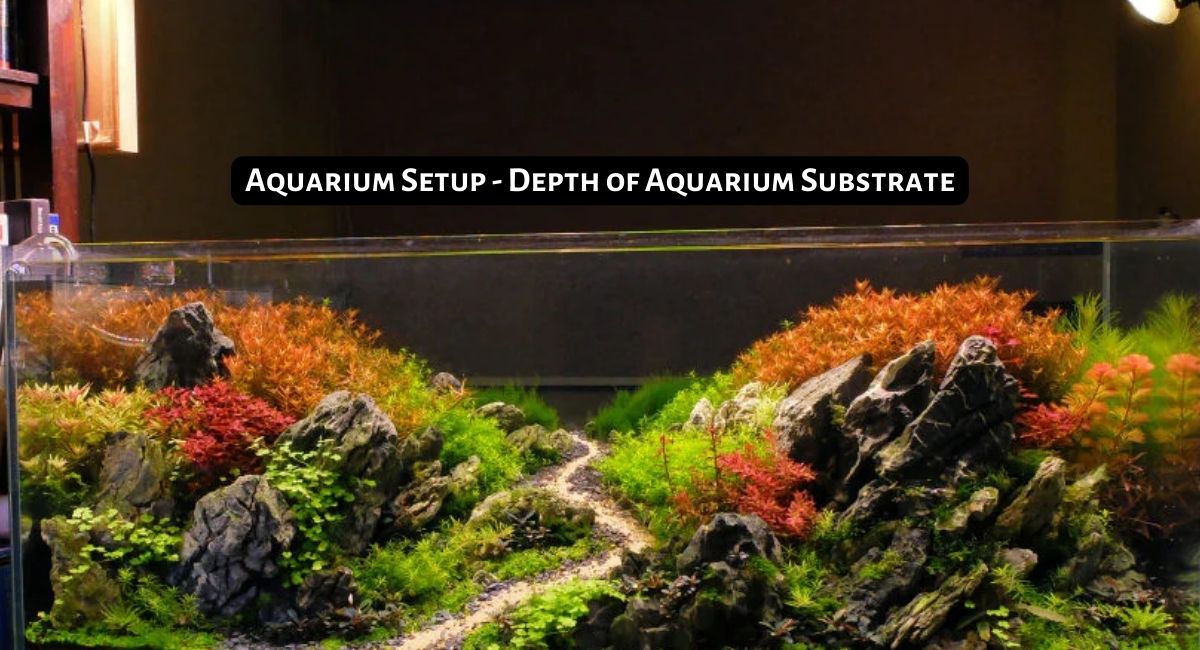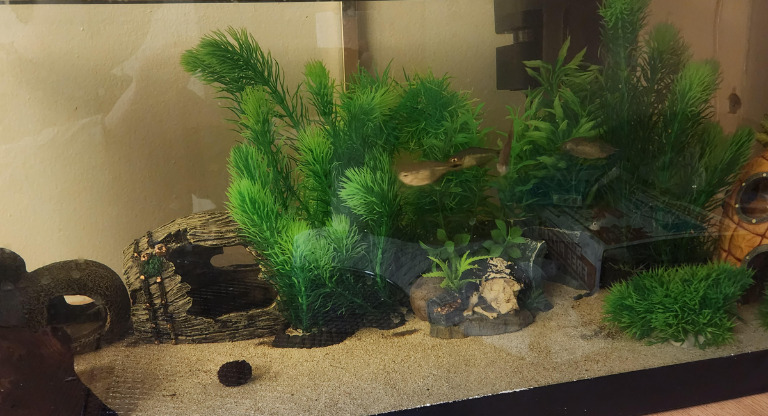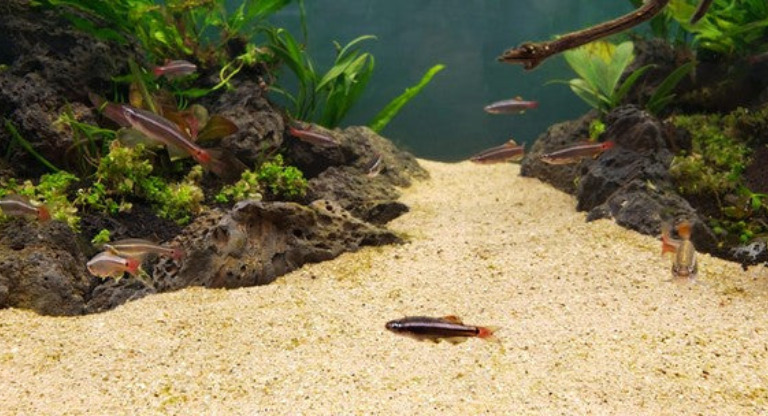Smartplantedaquarium.com participates in affiliate marketing programs. We may earn commissions on purchases made through our affiliate links. This doesn't affect our content or recommendations and we only recommend products we would put in our own tanks.
What is the ideal depth of aquarium substrate to ensure a healthy environment for your fish and plants?
When setting up an aquarium, one of the most important decisions you need to make is how much substrate should be used. Substrate, or the material at the bottom of your tank, plays a vital role in keeping your fish and plants healthy and thriving. The depth of the substrate can affect water chemistry and filtration, as well as the overall aesthetics of your tank.
Read on to learn more about the ideal depth of aquarium substrate and how it can impact your aquarium.
Contents
How Much Should the Depth of Aquarium Substrate be?
For an optimal setup, the depth of the substrate should be between two and four inches. This is enough to provide a stable foundation for your aquatic inhabitants, while still allowing for adequate water flow and filtration. You should avoid substrates that are too shallow, as these can become compacted over time and impede water movement. Too much substrate can also cause problems, as it restricts the oxygen exchange between the water and air. Additionally, an excess of substrate can lead to anaerobic pockets, which are areas with low oxygen and high levels of toxic gases. Finding the right balance is essential for a healthy aquarium.
What is a Substrate?
A substrate is the layer of material on the bottom of an aquarium that serves as a foundation for aquatic life. It can range from sand, gravel, rocks to soil or even eco-friendly alternatives such as dried leaves and bark. Substrates perform many functions in the aquarium – they provide a place for beneficial bacteria and other organisms to live, offer a home for plants to root in and create an environment that allows fish and other inhabitants of the aquarium to thrive.
In order to ensure a healthy aquarium environment with plenty of room for its inhabitants, it’s important to consider how much substrate should be used. How much substrate you use will depend on many factors including the size and shape of your aquarium, the type of inhabitants you plan to keep and the type of substrate you are using.
What Matters When Selecting Substrate?
It’s important to note that certain species may require different depths of substrate depending on their needs. For example, burrowing fish such as gobies or corydoras may need a deeper substrate in order to build their homes. In these cases, four inches or more is recommended. Certain plants may also require deeper substrates for root development and anchoring.
When selecting your substrate, make sure to choose materials that are appropriate for the type of tank you have. Different types of aquariums will require different types of substrate, so it’s important to do your research before making a purchase. The cleanliness and composition of the substrate should also be considered in order to ensure that it won’t negatively impact the water chemistry or health of your tank inhabitants.
How Much Substrate Do You Need?
The typical rule for aquarists is that 1 inch of substrate should be used for every gallon of water in the tank. This means a 10-gallon aquarium should have at least 10 inches of substrate in order to provide enough space for the beneficial bacteria and other organisms to survive.
It’s important to note that there are some exceptions to this rule. For example, if you plan on keeping fish or invertebrates with burrowing behavior, such as cichlids or crayfish, they may require more substrate than 1 inch per gallon of water, as they like to dig and create tunnels in the substrate.
In addition, some aquariums may require more or less substrate depending on the type of filtration system you’re using. For example, if you have an under-gravel filter or powerhead, then you may need to use more than 1 inch per gallon of water.
Finally, it’s important to remember that the substrate should never be deeper than the height of your aquarium decorations – this is to prevent any fish or other inhabitants from getting trapped underneath them.
As a rule of thumb, 1 inch of substrate should be used for every gallon of water in the tank, but there can be exceptions depending on your specific circumstances.
Ultimately, it’s important to ensure that the substrate is not deeper than the height of your decorations to avoid any potential issues.
Important Notes about Adding Substrate
When adding substrate to an aquarium, there are three primary factors to consider: material, size, and depth. Here are some do’s and don’ts to ensure the optimal depth of aquarium substrate:
Do’s:
– Choose a suitable material for your tank. There are many different types of materials available, so make sure to do your research and select one that best suits your tank’s environment.
– Select an appropriate size of substrate for the depth of your aquarium. Substrate should be large enough to allow biological filtration and gas exchange, but not too large to cause problems with the water flow.
– Consider the depth of the substrate. The depth of aquarium substrate should be approximately 1/3 to 1/2 the total height of your tank. This allows for adequate circulation and gas exchange, and creates a natural environment for your fish.
Dont’s:
– Avoid using materials that can leach toxins into the water. Certain types of substrates, such as soil or rocks, can release toxic chemicals that can harm your fish.
– Don’t use substrates that are too large for the depth of your aquarium. Substrate pieces that are too big may cause water flow problems and limit biological filtration and gas exchange.
– Don’t exceed the recommended depth for aquarium substrate. Depth too great can cause oxygen depletion, leading to an unhealthy environment for your fish.
Frequently Asked Questions (FAQs)
How thick should substrate be planted aquarium?
Generally, the recommended substrate depth for a planted tank is 3-5 inches (7.6-12.7 cm). This gives plants enough room to root and also helps maintain water parameters at optimal levels. If you are using a deep sand bed or have a large tank with tall plants, you may want to use a deeper substrate. A substrate that is too shallow can result in poor plant growth and higher levels of nitrates. It is also important to choose the right type of aquarium substrate for your specific setup; some substrates are better suited for certain types of plants than others. Researching which type of substrate is best for your tank will help ensure you get the most out of your aquarium.
What is the minimum depth of substrate?
In most cases, the minimum substrate depth for a planted aquarium is 2-3 inches. This ensures that the roots of your plants have enough space to spread out and absorb nutrients from the substrate. It also provides a stable environment for them to thrive in. With deeper substrates, you can also increase the buffering capacity of your tank by adding minerals and other nutrients to the bottom layer of substrate. This can help maintain a balanced pH level for your aquarium and provide plants with an optimal environment for growth.
How deep should gravel be in aquarium?
The depth of the gravel in an aquarium depends on a few factors such as the size and type of fish that you have. Generally, it should be at least two inches deep for smaller species of fish, while larger species may require three to four inches. The deeper gravel layers are beneficial because they provide more space for beneficial bacteria to grow and proliferate. Additionally, deeper gravel helps to anchor plants in the aquarium and makes it easier for any fish that require digging or burrowing to do so.
Conclusion
The depth of the aquarium substrate is an important factor to consider when setting up a tank. It needs to be deep enough to allow for adequate filtration and aeration, while shallow enough to prevent gas pockets from forming. Ultimately, the goal should be to find the right balance between filtration and oxygenation that will support healthy aquatic life. Depth is just one piece of the puzzle when it comes to aquarium maintenance, as there are other aspects to consider such as water quality, temperature, and pH levels.
By keeping these factors in mind and creating an environment that supports healthy aquatic life, you can ensure that your fish will have a happy and thriving home for years to come!






